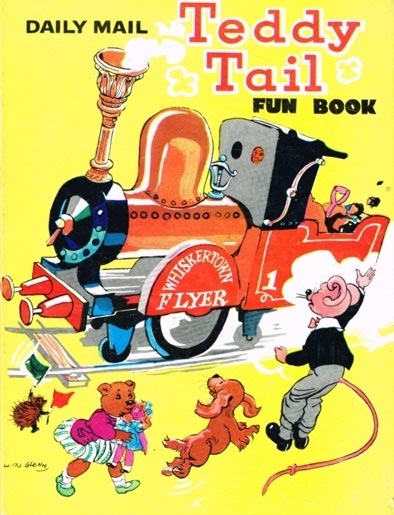'Ballyscunnion' (1 January 1955).
William St. John Glenn, or "Bill Glenn" in short, was a Northern-Irish/British painter, cartoonist and occasional comic artist. He is best remembered for such daily comics as 'Oscar' (1926-1936), 'Dorothea' (1936-1939) and his 'Ballyscunnion' (1938-1969) cartoons. He was also the final artist to draw the funny animal children's comic strip 'Teddy Tail' for the Daily Mail.
Early life and career
William St. John Glenn was born in 1904 in Belfast, where he studied at the Belfast School of Art. By the time he was 16, he saw his first illustrations published in the sports paper Ireland's Saturday Night. This motivated him to not choose for a career in medicine, as planned, but go ahead and draw cartoons. For a period of five years, he was employed as an illustrator by the publishing house Graham and Heslip Ltd. Between 1926 and 1936, Glenn worked for the newspaper The Belfast Telegraph as a staff artist, photographer, columnist, editor and comic artist. His written pieces were published under the pen name "The Gay Philosopher".
Oscar/Dorothea
In May 1926, Glenn created his own daily comic strip 'Oscar' (1926-1936) for the Belfast Telegraph, which was also syndicated to newspapers in Australia and South Africa. 'Oscar' starred a little bespectacled man with a long nose who walked around in baggy trousers. Later that year, Glenn met his future wife, Dorothea, which inspired him to give Oscar an attractive female partner, also named Dorothea. On 31 August 1936, Glenn published a new strip dedicated fully to 'Dorothea' in another newspaper, The Daily Mail. Six months later, Glenn left The Belfast Telegraph permanently and joined the Daily Mail. 'Dorothea' was popular with readers, particularly women, and was also published in South Africa, Scandinavia and Australia. The protagonist was often seen wearing new styles of fashion, which led some readers into believing that Glenn was a woman, since he appeared to know so much about the topic. 'Dorothea' additionally gained praise for its experimental lay-out, and ran until 1939.
Ballyscunnion and other magazine work
From 1928 on, Glenn also drew cartoons and covers for the Irish satirical monthly magazine Dublin Opinion, which he signed "William St John" with a diamond-shaped "o". However, his best known feature for this publication was 'Ballyscunnion' (1938-1968), a cartoon panel set in an average but fictional Irish village. The villagers were often commenting on whatever was in the news, and Glenn drew the cartoons using a scraperboard covered in white china. He inked this surface black and scratched it, which gave the illustrations the appearance of a woodcut. The cartoons ran for more than 30 years until the Dublin Opinion was discontinued.
In the early 1930s, St. John Glenn's single-panel gag cartoon 'Simple Simon' (1931-1934) ran in Ireland's Saturday Night. It starred a simple-minded blond young boy who often asked and made stupid questions and remarks. Glenn's illustrations additionally appeared in Judge, The Passing Show, Modern Girl, the London Opinion, Radio Times and Scout, as well as The Observer, Punch, Everywoman and Autocar. It is said that he also drew a comic strip based on the 18th-century literary classic 'The Diary of Samuel Pepys'.
World War II
In 1940, Glenn was diagnosed with a brain tumor. He underwent surgery, which interrupted his graphic career for a long time. During World War II, he worked for the Ministry of Information, editing photographs and newsreel footage for public release, as well producing educational films. After the war, Glenn returned to the Daily Mail as editor of the comics and cartoons section. He initiated the Strip Cartoons Department and commissioned artists and photographers.
Teddy Tail
Between 1954 and the early 1960s, Glenn was the artist of the Daily Mail's funny animal strip 'Teddy Tail'. Originally created in 1915 by Charles James Folkard, the strip had been relaunched and created during the post-war years by Arthur Potts and his assistant Tony Hawes. Bill Glenn was the last artist to draw the adventures of the little mouse, until the feature was cancelled around 1962. Glenn also made illustrations for the Daily Mail Blue Spot Annuals, and designed covers for the Teddy Tail Annuals.
Final years and death
After additional brain surgery in 1951 and 1961, William St. John Glenn retired from The Daily Mail. During his final years, Glenn helped the Chelsea Cine Club, and provided photos and articles to the Chelsea News. During his lifetime, Bill Glenn enjoyed a prolific status. He was a member of the Institute of Journalists, the Ulster Academy of Art and saw his 'Ballyscunnion' work exhibited several times. During the 1960s, Glenn was elected as Vice-President and later Honorary Academician of the Royal Ulster Academy. William St. John Glenn died in a hospital in Chelsea in June 1974.
'Teddy Tail'.







